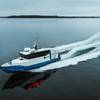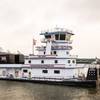Largest Wellboat Hull Arrives Norway Yard
The hull of the Ronja Storm, which is destined to become the world’s biggest wellboat, has arrived at the Havyard shipyard in Norway for fitting out after construction in Turkey.
Ronja Storm will be the world’s biggest in more ways than just being much longer than other wellboats at 116 metres. There are also no other ships in the world that have such a big freshwater production facility.
The boat can produce 16.8 million litres of freshwater a day, thereby potentially covering the daily freshwater consumption of 100,000 average Norwegians.
Nor are there any other wellboats that can match her fish tank capacity or have such a great capacity for processing and transport of fish. Its capacity is nearly twice that of the average wellboat. No other boats have four fish tanks, and no others can load 1,000 tonnes of fish an hour. That means 3,300 big salmon per minute.
In addition, no other wellboats have used a direct current system before. Ronja Storm is the very first, and the system will save fuel and ensure good handling of the fish.
Senior designer Kjetil Myren at Havyard Design & Solution refers to Ronja Storm as groundbreaking.
Kjetil said: "Ronja Storm is the biggest in the world not only in terms of its actual size. The focus has been on thorough and reliable handling of large amounts of fish, which has required new solutions and equipment to be developed. Clients and end users have challenged us down to the tiniest detail, and the result is that Ronja Storm will be a giant in every way."
Lasse Stokkeland, EVP Havyard Ship Technology, refers to the yard’s experience with building wellboats and says that they are ready.
Lasse said: "We’ve been preparing for this for a long time, and we benefit from it being a complete Havyard product both in terms of the planning and building processes. We have full access to expertise in all fields when it comes to design, the fish handling equipment itself, and power systems and automation."
Ronja Storm is being built for Sølvtrans, which will rent the wellboat to Huon Aquaculture in Tasmania just off Australia. Kjetil Myren explains that the fish transporting and processing needs there require the large dimensions.
"The salmon must be treated and transported many times throughout their life cycle and bathing the fish in freshwater is an effective and environmentally friendly method. Producing our own freshwater makes the treatment more sustainable, as you avoid using natural freshwater, which is a scarce resource, you save time and fuel from not having to fetch it, and you don’t have to filter it. The water is of course reused as well," Kjetil said.









